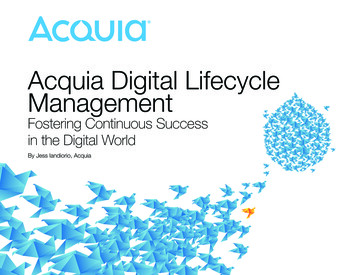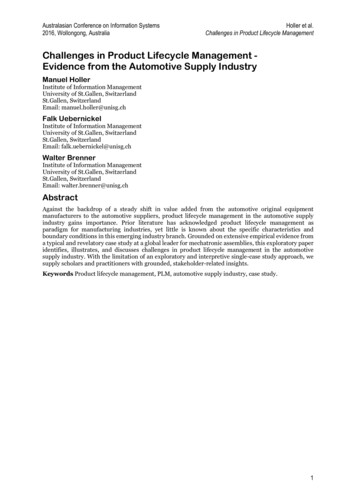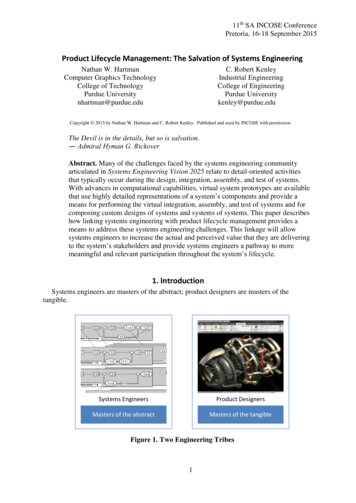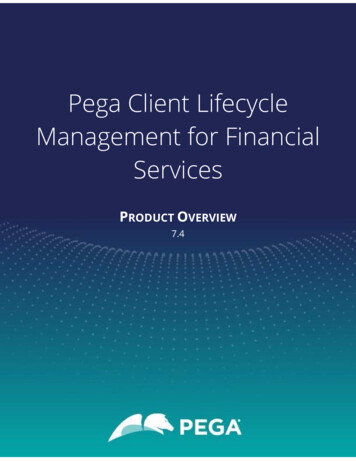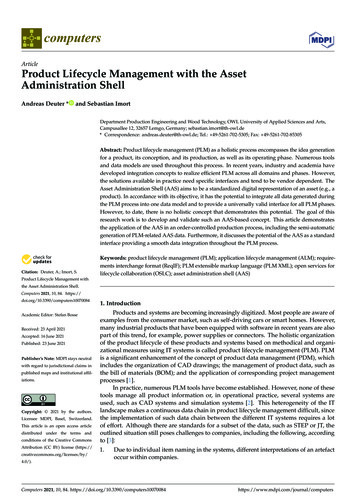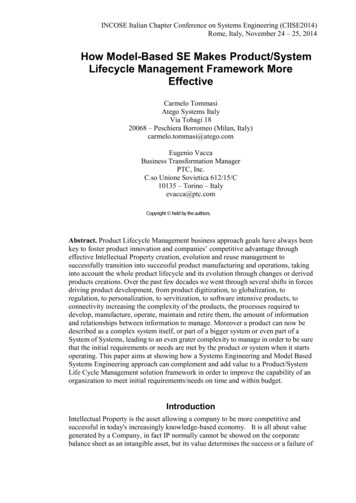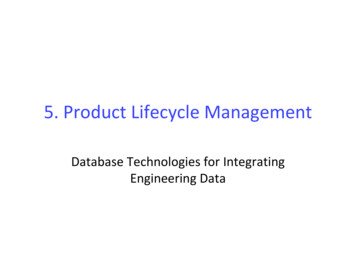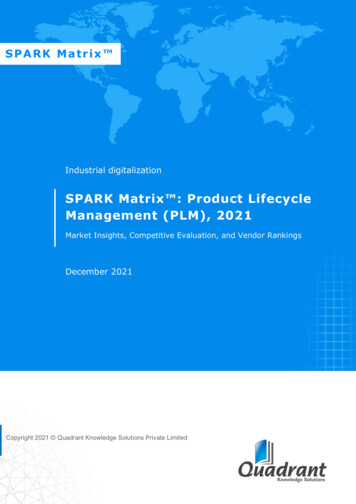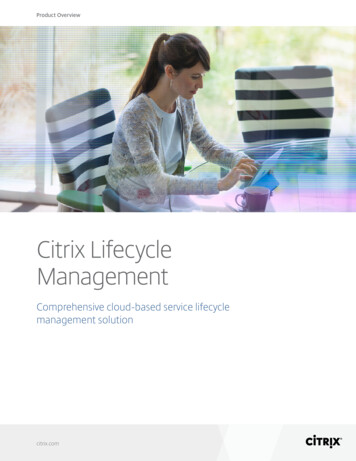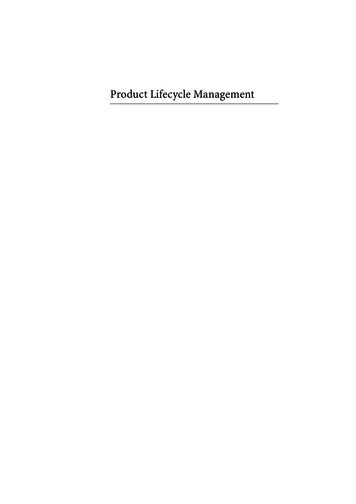
Transcription
Product Lifecycle Management
Antti Saaksvuori Anselmi ImmonenProduct LifecycleManagementThird EditionWith 62 Figures and 5 Tables
Dipl. Ing. Antti SaaksvuoriNuottatie 8 E02230 EspooFinlandantti.saaksvuori@iki.fiDipl. Ing. Anselmi ImmonenPohjoiskaari 600200 HelsinkiFinlandanselmi immonen@rocla.comOriginal Finnish edition published by Talentum, 2002ISBN: 978-3-540-78173-8e-ISBN: 978-3-540-78172-1DOI: 10.1007/978-3-540-78172-1Library of Congress Control Number: 2008922905 2008, 2005, 2003 Springer-Verlag Berlin HeidelbergThis work is subject to copyright. All rights are reserved, whether the whole or part of the material isconcerned, specifically the rights of translation, reprinting, reuse of illustrations, recitation, broadcasting,reproduction on microfilm or in any other way, and storage in data banks. Duplication of this publicationor parts thereof is permitted only under the provisions of the German Copyright Law of September 9,1965, in its current version, and permission for use must always be obtained from Springer. Violations areliable to prosecution under the German Copyright Law.The use of general descriptive names, registered names, trademarks, etc. in this publication does notimply, even in the absence of a specific statement, that such names are exempt from the relevant protectivelaws and regulations and therefore free for general use.Product liability: The publisher cannot guarantee the accuracy of any information about dosage andapplication contained in this book. In every individual case the user must check such information byconsulting the relevant literature.Cover design: WMXDesign GmbH, Heidelberg, GermanyPrinted on acid-free paper9 8 7 6 5 4 3springer.com
PrefaceThe significance of product lifecycle management (PLM – Product LifecycleManagement, formerly referred to, in a narrower frame of reference, as PDM –Product Data Management) is increasing, especially for companies in themanufacturing, high technology, and service industries. Product and componentlifecycles are shortening while, at the same time, new products must be deliveredto market more quickly than before. Many manufacturing and service companiesare also trying to grow out of a bulk provider role. In the future they will be providing configurable and flexible solutions rather than just individual products.This leads companies to form networks in which each actor specializes in theplanning, manufacture or integration of products in a certain field. Informationconcerning common products must pass quickly, faultlessly, and automaticallybetween companies so that they can compete effectively in international markets.In today’s industrial production, therefore, PLM is an essential tool for copingwith the challenges of more demanding global competition and ever-shorteningproduct and component lifecycles and growing customer needs. New, better andmore flexible products must be introduced into markets more quickly, with moreprofit and less labor, and the lifecycle of each product must be better controlled,for example, from financial and environmental perspectives. Fierce competitionin global markets drives companies to perform better. In order to perform wellfinancially, companies must be able to make informed decisions concerning thelifecycle of each product in their portfolio. Winner products must be introducedinto the market quickly and poorly performing products must be removed fromthe market. To do this well, companies must have a very good idea of the lifecycle of each product. A good command of product and process definitions overa large product portfolio requires that ways of operation and IT-systems mustsupport each other flawlessly.Today’s complex products require the collaboration of large specialist networks. In this kind of supplier and partner network, product data must be transferred between companies in electronic form, with a high level of informationsecurity. Overall, PLM can also be considered a tool for collaboration in thesupply network and for managing product creation and lifecycle processes in
VIPrefacetoday’s networked world, bringing new products to the market with less expenditureof time and effort.This book is intended as a manual of product lifecycle and product informationmanagement. It will support PLM/PDM concepts and system implementation projectsas well as providing ideas for developing product data and product lifecycle management in businesses.The book will be useful, for instance, to:1.2.3.4.5.6.7.8.Product managersBusiness managersR&D organizationsPLM-projects and project-personnel in the companies, documentingmanagers, product creation and R&D Organizations, sourcing and procurement, after sales organizations, business development organizations, IT-managers, IT-personnelPLM-consultantsAfter sales organizationsEducational organizationsUniversity studentsThe book deals with the term PDM in its wider significance: the context inwhich the proper modern term or acronym is PLM – Product Lifecycle Management. We think of PDM, or Product Data Management, as a useful tool for controlling product-related information as well as the lifecycle of a product.The two acronyms PDM and PLM are closely associated; the main differenceis one of scope and purpose. Whereas PDM is mainly a set of tools and methods aimed at efficiently managing product data, PLM is a holistic approach thatuses a wide range of different concepts, technologies, and tools, which extend togroups beyond the functions of a company or even a supply network in order tomanage and control the lifecycle of a product.The starting point for this book has been that PDM really covers the wholelifespan of the product and the whole spectrum of product data. It is not concerned only with product-related CAD files. We are using the term PLM – Product Lifecycle Management – to describe the wider frame of reference of productdata. PLM, in this book, refers to this wider totality, especially with the aim ofsettling the continuously changing and flickering terminology of the field.Traditionally PLM has been a business concept for the tangibles business andespecially for goods manufacturing. This tradition is very visible in this book
PrefaceVIIalso. However, the importance of PLM in the intangibles (e.g. software and services)business has grown dramatically during the past two years and therefore someaspects of using PLM in the intangibles business has been added to the third edition of this book. When reading this book, the reader should bear in mind thateven though most of the chapters have been written initially with a tangiblesbusiness mindset, most of the principles explained and featured are applicablealso in the intangibles businesses. Chapter 9 of this book is new and has beenwritten solely for the services business.Chapters 2, 3 and 4 cover the fundamentals and concepts of product lifecyclemanagement and terminology. Chapter 5 considers the different roles of information processing systems within the company from the viewpoint of product information management. Chapters 6, 7 and 8 survey the deployment and completionof implementation projects for PLM systems; case examples concretize the useof systems in companies making different kinds of products. Chapter 9 will focuson service products and the utilization of PLM in service industry. Chapters 10,11 and 13 envisage PLM concept from a markedly wider perspective, thinking in terms of the development of the business. The final chapter considers thesignificance of cooperation or collaboration between companies and the role ofPLM in this.In February 2008Antti SaaksvuoriAnselmi Immonen
Table of ContentsPreface . . . . . . . . . . . . . . . . . . . . . . . . . . . . . . . . . . . . . . . . . . . . . . . . . . . . . . . . vChapter 1 – Introduction . . . . . . . . . . . . . . . . . . . . . . . . . . . . . . . . . . . . . . . . . 1What is a product? . . . . . . . . . . . . . . . . . . . . . . . . . . . . . . . . . . . . . . . . . . . . . 1PLM: What is it? . . . . . . . . . . . . . . . . . . . . . . . . . . . . . . . . . . . . . . . . . . . . . . 1Product Lifecycle Management: background . . . . . . . . . . . . . . . . . . . . . . . . 3Corporate challenges . . . . . . . . . . . . . . . . . . . . . . . . . . . . . . . . . . . . . . . . . . . 5Chapter 2 – Fundamentals . . . . . . . . . . . . . . . . . . . . . . . . . . . . . . . . . . . . . . . . 7Product data or Product information . . . . . . . . . . . . . . . . . . . . . . . . . . . . . . . 7Product Lifecycle Management (PLM) . . . . . . . . . . . . . . . . . . . . . . . . . . . . . 9Product lifecycle management concept . . . . . . . . . . . . . . . . . . . . . . . . . . . . 11Items . . . . . . . . . . . . . . . . . . . . . . . . . . . . . . . . . . . . . . . . . . . . . . . . . . . . . . 11Product lifecycle management systems . . . . . . . . . . . . . . . . . . . . . . . . . . . . 13System architecture . . . . . . . . . . . . . . . . . . . . . . . . . . . . . . . . . . . . . . . . . . . 17Information models and product structures . . . . . . . . . . . . . . . . . . . . . . . . . 21Information model . . . . . . . . . . . . . . . . . . . . . . . . . . . . . . . . . . . . . . . . . . 21The product information (data) model. . . . . . . . . . . . . . . . . . . . . . . . . . . 22The product model . . . . . . . . . . . . . . . . . . . . . . . . . . . . . . . . . . . . . . . . . . 22Reasons for the deployment of PLM systems . . . . . . . . . . . . . . . . . . . . . . . 24Summary . . . . . . . . . . . . . . . . . . . . . . . . . . . . . . . . . . . . . . . . . . . . . . . . . . . 25Chapter 3 – Product lifecycle management systems . . . . . . . . . . . . . . . . . . 27Functionality of the systems . . . . . . . . . . . . . . . . . . . . . . . . . . . . . . . . . . . . 27Use of product lifecycle management systems in differentorganization verticals . . . . . . . . . . . . . . . . . . . . . . . . . . . . . . . . . . . . . . . . . . 36Product development and engineering. . . . . . . . . . . . . . . . . . . . . . . . . . . . . 38Production . . . . . . . . . . . . . . . . . . . . . . . . . . . . . . . . . . . . . . . . . . . . . . . . . . 39After sales . . . . . . . . . . . . . . . . . . . . . . . . . . . . . . . . . . . . . . . . . . . . . . . . . . 40Sales and marketing . . . . . . . . . . . . . . . . . . . . . . . . . . . . . . . . . . . . . . . . . . . 40Sub-contracting . . . . . . . . . . . . . . . . . . . . . . . . . . . . . . . . . . . . . . . . . . . . . . 41Sourcing and procurement . . . . . . . . . . . . . . . . . . . . . . . . . . . . . . . . . . . . . . 43Summary . . . . . . . . . . . . . . . . . . . . . . . . . . . . . . . . . . . . . . . . . . . . . . . . . . . 44
XTable of ContentsChapter 4 – Product structures . . . . . . . . . . . . . . . . . . . . . . . . . . . . . . . . . . . 45Example 1: Product structure of a ship. . . . . . . . . . . . . . . . . . . . . . . . . . . 47Example 2: Product structure of a cellular telephone . . . . . . . . . . . . . . . . 48Example 3: Product structure of a customizable product . . . . . . . . . . . . . 50Example 4: Product structure of a configurable service product . . . . . . . 51Summary . . . . . . . . . . . . . . . . . . . . . . . . . . . . . . . . . . . . . . . . . . . . . . . . . . . 52Chapter 5 – Integration of the PLM system with other applications . . . . 53Different ways to integrate PLM systems . . . . . . . . . . . . . . . . . . . . . . . . 53Transfer file . . . . . . . . . . . . . . . . . . . . . . . . . . . . . . . . . . . . . . . . . . . . . . . . . 55Database integration . . . . . . . . . . . . . . . . . . . . . . . . . . . . . . . . . . . . . . . . 57System roles. . . . . . . . . . . . . . . . . . . . . . . . . . . . . . . . . . . . . . . . . . . . . . . 58ERP . . . . . . . . . . . . . . . . . . . . . . . . . . . . . . . . . . . . . . . . . . . . . . . . . . . . . 58CAD . . . . . . . . . . . . . . . . . . . . . . . . . . . . . . . . . . . . . . . . . . . . . . . . . . . . . 60Configurators . . . . . . . . . . . . . . . . . . . . . . . . . . . . . . . . . . . . . . . . . . . . . . 61EAI. . . . . . . . . . . . . . . . . . . . . . . . . . . . . . . . . . . . . . . . . . . . . . . . . . . . . . 63Summary . . . . . . . . . . . . . . . . . . . . . . . . . . . . . . . . . . . . . . . . . . . . . . . . . . . 65Chapter 6 – Deployment of the PLM system . . . . . . . . . . . . . . . . . . . . . . . . 67Different stages of deployment . . . . . . . . . . . . . . . . . . . . . . . . . . . . . . . . . . 67Leading a PLM project . . . . . . . . . . . . . . . . . . . . . . . . . . . . . . . . . . . . . . 68Understanding the need for change . . . . . . . . . . . . . . . . . . . . . . . . . . . . . 68Study of present and objective processes (AS IS and TO BE) . . . . . . . . . . 69PLM maturity model . . . . . . . . . . . . . . . . . . . . . . . . . . . . . . . . . . . . . . . . 70Choosing a system . . . . . . . . . . . . . . . . . . . . . . . . . . . . . . . . . . . . . . . . . . . . 70Realization stage of the project . . . . . . . . . . . . . . . . . . . . . . . . . . . . . . . . . . 75Start up. . . . . . . . . . . . . . . . . . . . . . . . . . . . . . . . . . . . . . . . . . . . . . . . . . . 77Steering group . . . . . . . . . . . . . . . . . . . . . . . . . . . . . . . . . . . . . . . . . . . . . 79Project group . . . . . . . . . . . . . . . . . . . . . . . . . . . . . . . . . . . . . . . . . . . . . . 80Project manager . . . . . . . . . . . . . . . . . . . . . . . . . . . . . . . . . . . . . . . . . . . . 82Problems . . . . . . . . . . . . . . . . . . . . . . . . . . . . . . . . . . . . . . . . . . . . . . . . . 83Accomplishing change in the organization . . . . . . . . . . . . . . . . . . . . . . . . . 85Summary . . . . . . . . . . . . . . . . . . . . . . . . . . . . . . . . . . . . . . . . . . . . . . . . . . . 89Chapter 7 – Business benefits of a PLM system. . . . . . . . . . . . . . . . . . . . . . 91Factors leading to product lifecycle management . . . . . . . . . . . . . . . . . . . . 91Benefits of the PLM system in product lifecycle management . . . . . . . . . . 93Measuring the business benefits in daily operations . . . . . . . . . . . . . . . . . . 97Material costs: reducing inventory tied capital . . . . . . . . . . . . . . . . . . . . . . 97Improving the productivity of labor . . . . . . . . . . . . . . . . . . . . . . . . . . . . . . 99Costs of quality . . . . . . . . . . . . . . . . . . . . . . . . . . . . . . . . . . . . . . . . . . . . . 101PLM and data warehousing as a tool to support decision-making . . . . . . 103Analyzing the cost of acquisition and the deployment of a PLM system . 107
Table of ContentsXIPLM software licenses. . . . . . . . . . . . . . . . . . . . . . . . . . . . . . . . . . . . . . . . 109Database licenses . . . . . . . . . . . . . . . . . . . . . . . . . . . . . . . . . . . . . . . . . . . . 110Hardware acquisitions . . . . . . . . . . . . . . . . . . . . . . . . . . . . . . . . . . . . . . . . 110Maintenance of equipment, licenses and software . . . . . . . . . . . . . . . . . . 110Summary . . . . . . . . . . . . . . . . . . . . . . . . . . . . . . . . . . . . . . . . . . . . . . . . . . 110Chapter 8 – Challenges of product managementin manufacturing industry . . . . . . . . . . . . . . . . . . . . . . . . . . . . . . . . . . . . . . 111Challenges of product management in the engineeringand manufacturing industry . . . . . . . . . . . . . . . . . . . . . . . . . . . . . . . . . . . . 111Life cycle thinking, value added services and after sales . . . . . . . . . . . 111Traceability . . . . . . . . . . . . . . . . . . . . . . . . . . . . . . . . . . . . . . . . . . . . . . 115Special challenges of product management in the high tech industry . . . . 121Case 1: Electronics manufacturer . . . . . . . . . . . . . . . . . . . . . . . . . . . . . . . 122Efficiency as a goal . . . . . . . . . . . . . . . . . . . . . . . . . . . . . . . . . . . . . . . . 122The management of the company set the following primaryobjectives for the PLM project . . . . . . . . . . . . . . . . . . . . . . . . . . . . . . . 123Starting the project. . . . . . . . . . . . . . . . . . . . . . . . . . . . . . . . . . . . . . . . . 125Execution of the project . . . . . . . . . . . . . . . . . . . . . . . . . . . . . . . . . . . . . 126In the next stage partners came along . . . . . . . . . . . . . . . . . . . . . . . . . . 127Case 2: An engineering product . . . . . . . . . . . . . . . . . . . . . . . . . . . . . . . . 129Situation at the beginning of the project . . . . . . . . . . . . . . . . . . . . . . . . 129Management of items . . . . . . . . . . . . . . . . . . . . . . . . . . . . . . . . . . . . . . 130Approval of documents . . . . . . . . . . . . . . . . . . . . . . . . . . . . . . . . . . . . . 131Management of the product structure . . . . . . . . . . . . . . . . . . . . . . . . . . 131Information system environment in use . . . . . . . . . . . . . . . . . . . . . . . . 131Integration of information processing systems . . . . . . . . . . . . . . . . . . . 132Standard design solutions . . . . . . . . . . . . . . . . . . . . . . . . . . . . . . . . . . . 132Frame of reference for product management . . . . . . . . . . . . . . . . . . . . . . 133Problem sections of the product management . . . . . . . . . . . . . . . . . . . . 134Developing product lifecycle management in project workshop Plc. . . . . 135Management of documents . . . . . . . . . . . . . . . . . . . . . . . . . . . . . . . . . . 135Management of the product structure . . . . . . . . . . . . . . . . . . . . . . . . . . 137Change management and workflows . . . . . . . . . . . . . . . . . . . . . . . . . . . 137The advantages and development potential brought by the productlifecycle management system . . . . . . . . . . . . . . . . . . . . . . . . . . . . . . . . . . 139Pilot . . . . . . . . . . . . . . . . . . . . . . . . . . . . . . . . . . . . . . . . . . . . . . . . . . . . 140Experiences of the pilot . . . . . . . . . . . . . . . . . . . . . . . . . . . . . . . . . . . . . 141What next? . . . . . . . . . . . . . . . . . . . . . . . . . . . . . . . . . . . . . . . . . . . . . . . 143Case 3: Capital goods manufacturer and customer-specificallyvariable product . . . . . . . . . . . . . . . . . . . . . . . . . . . . . . . . . . . . . . . . . . . . . 143Breakthroughs on subprojects . . . . . . . . . . . . . . . . . . . . . . . . . . . . . . . . . . 145Controlled entry of documentation into the system. . . . . . . . . . . . . . . . . . 145
XIITable of ContentsThe business processes determine . . . . . . . . . . . . . . . . . . . . . . . . . . . . . . . 146Rome was not built in a day either . . . . . . . . . . . . . . . . . . . . . . . . . . . . . . 146Guidelines for the future . . . . . . . . . . . . . . . . . . . . . . . . . . . . . . . . . . . . . . 147Summary . . . . . . . . . . . . . . . . . . . . . . . . . . . . . . . . . . . . . . . . . . . . . . . . . . 147Chapter 9 – Service industry and PLM . . . . . . . . . . . . . . . . . . . . . . . . . . . 149Introduction . . . . . . . . . . . . . . . . . . . . . . . . . . . . . . . . . . . . . . . . . . . . . . . . 149What is a service? . . . . . . . . . . . . . . . . . . . . . . . . . . . . . . . . . . . . . . . . . . . 150Categorizing services . . . . . . . . . . . . . . . . . . . . . . . . . . . . . . . . . . . . . . . 154Why should services be made more like tangible products? . . . . . . . . . 156Rational for building service products. . . . . . . . . . . . . . . . . . . . . . . . . . 156When is further productization of services useful? . . . . . . . . . . . . . . . . 158How to make a service more like a tangible product? . . . . . . . . . . . . . . 160PLM in service business . . . . . . . . . . . . . . . . . . . . . . . . . . . . . . . . . . . . . . 164PLM challenges in service business . . . . . . . . . . . . . . . . . . . . . . . . . . . 164How can be services modularized? . . . . . . . . . . . . . . . . . . . . . . . . . . . . 166Making items out of product functions . . . . . . . . . . . . . . . . . . . . . . . . . 168Case 4: An IT-service (managed services) provider and acustomer-specifically variable product . . . . . . . . . . . . . . . . . . . . . . . . . . . 169Stage number one . . . . . . . . . . . . . . . . . . . . . . . . . . . . . . . . . . . . . . . . . 171The second stage . . . . . . . . . . . . . . . . . . . . . . . . . . . . . . . . . . . . . . . . . . 172The third and final stage of the implementation . . . . . . . . . . . . . . . . . . 173The aftermath. . . . . . . . . . . . . . . . . . . . . . . . . . . . . . . . . . . . . . . . . . . . . 175What next? . . . . . . . . . . . . . . . . . . . . . . . . . . . . . . . . . . . . . . . . . . . . . . . 176Summary . . . . . . . . . . . . . . . . . . . . . . . . . . . . . . . . . . . . . . . . . . . . . . . . . . 176Chapter 10 – The role of product information managementin collaborative business development . . . . . . . . . . . . . . . . . . . . . . . . . . . . 177CIM: Computer integrated manufacturing . . . . . . . . . . . . . . . . . . . . . . . . 177CE: Concurrent engineering . . . . . . . . . . . . . . . . . . . . . . . . . . . . . . . . . . . 180Product lifecycle management as an enabler of cooperationbetween companies . . . . . . . . . . . . . . . . . . . . . . . . . . . . . . . . . . . . . . . . . . 183Contents of collaboration. . . . . . . . . . . . . . . . . . . . . . . . . . . . . . . . . . . . . . 185Successful cooperation . . . . . . . . . . . . . . . . . . . . . . . . . . . . . . . . . . . . . . . 186Tools of collaboration . . . . . . . . . . . . . . . . . . . . . . . . . . . . . . . . . . . . . . . . 187International standardization organizations . . . . . . . . . . . . . . . . . . . . . . 187CPC . . . . . . . . . . . . . . . . . . . . . . . . . . . . . . . . . . . . . . . . . . . . . . . . . . . . . . 188cPDm . . . . . . . . . . . . . . . . . . . . . . . . . . . . . . . . . . . . . . . . . . . . . . . . . . . . . 189Summary . . . . . . . . . . . . . . . . . . . . . . . . . . . . . . . . . . . . . . . . . . . . . . . . . . 190Chapter 11 – Understanding the product lifecycle . . . . . . . . . . . . . . . . . . 191The basic behavior of products and lifecycles . . . . . . . . . . . . . . . . . . . . . . 192Using metrics to steer your business performance in variousphases of the product lifecycle . . . . . . . . . . . . . . . . . . . . . . . . . . . . . . . 193
Table of ContentsXIIIOther aspects of product lifecycle . . . . . . . . . . . . . . . . . . . . . . . . . . . . . 196Product lifecycle: data (information) management view. . . . . . . . . . . . 196Building a product business case . . . . . . . . . . . . . . . . . . . . . . . . . . . . . . . . 198Summary . . . . . . . . . . . . . . . . . . . . . . . . . . . . . . . . . . . . . . . . . . . . . . . . . . 205Chapter 12 – Product and product management strategyas a part of business strategy . . . . . . . . . . . . . . . . . . . . . . . . . . . . . . . . . . . . 207Product lifecycle management as a business strategy tool . . . . . . . . . . . . 207From changes in the business environment to product strategy . . . . . . . . 208Making a product strategy . . . . . . . . . . . . . . . . . . . . . . . . . . . . . . . . . . . . . 210Product management strategy . . . . . . . . . . . . . . . . . . . . . . . . . . . . . . . . . . 212Time to market: the time required to bring a new product to market . . 214Time to react: the time required to carry out the changesdemanded by the market and customers . . . . . . . . . . . . . . . . . . . . . . . . 216Time to volume: the time required for ramping up the massproduction of the product . . . . . . . . . . . . . . . . . . . . . . . . . . . . . . . . . . . 217Time to service: the response time to a service orderfrom the customer . . . . . . . . . . . . . . . . . . . . . . . . . . . . . . . . . . . . . . . . . 219Summary . . . . . . . . . . . . . . . . . . . . . . . . . . . . . . . . . . . . . . . . . . . . . . . . . . 220Chapter 13 – e-Business: electronic business and PLM . . . . . . . . . . . . . . 221Preconditions for electric business from the viewpointof the individual company . . . . . . . . . . . . . . . . . . . . . . . . . . . . . . . . . . . . . 224Significance of product management, collaboration and electronicbusiness for the manufacturing industry . . . . . . . . . . . . . . . . . . . . . . . . . . 227Summary . . . . . . . . . . . . . . . . . . . . . . . . . . . . . . . . . . . . . . . . . . . . . . . . . . 227Chapter 14 – Digest. . . . . . . . . . . . . . . . . . . . . . . . . . . . . . . . . . . . . . . . . . . . 229Epilogue . . . . . . . . . . . . . . . . . . . . . . . . . . . . . . . . . . . . . . . . . . . . . . . . . . . . . 233Appendix 1 – Tools and standards of PLM . . . . . . . . . . . . . . . . . . . . . . . . 235A. CALS . . . . . . . . . . . . . . . . . . . . . . . . . . . . . . . . . . . . . . . . . . . . . . . . . 235B. STEP . . . . . . . . . . . . . . . . . . . . . . . . . . . . . . . . . . . . . . . . . . . . . . . . . . 236C. DXF . . . . . . . . . . . . . . . . . . . . . . . . . . . . . . . . . . . . . . . . . . . . . . . . . . . 238D. IGES . . . . . . . . . . . . . . . . . . . . . . . . . . . . . . . . . . . . . . . . . . . . . . . . . . 239E. SGML . . . . . . . . . . . . . . . . . . . . . . . . . . . . . . . . . . . . . . . . . . . . . . . . . 239F. XML . . . . . . . . . . . . . . . . . . . . . . . . . . . . . . . . . . . . . . . . . . . . . . . . . . . 240G. UML . . . . . . . . . . . . . . . . . . . . . . . . . . . . . . . . . . . . . . . . . . . . . . . . . . 240Appendix 2 – Companies and products in the PLM field . . . . . . . . . . . . . 243Appendix 3 – PLM terminology . . . . . . . . . . . . . . . . . . . . . . . . . . . . . . . . . 245Literature and articles . . . . . . . . . . . . . . . . . . . . . . . . . . . . . . . . . . . . . . . . . 251
Chapter 1 – IntroductionProduct lifecycle management makes it possible to command the whole lifespan ofa product and the information connected with it. Efficient product lifecycle management enables companies to compete successfully in international and global markets.What is a product?Usually, when talking about products we mean tangible products i.e. goods. Theterm goods refers to physical, tangible products that can be owned, traded, anddistributed to different places at different times without changing their identity.However, a product in a modern world can also be something very intangiblesuch as a piece of software, a piece of knowledge or an algorithm or a formula.They are products as much as tangible products are.When referring to a product in this book, we refer to three different kinds ofproducts:1.Goods meaning physical, tangible products2.Services (a definition for services will be addressed in more detail inchapter 9)3.Intangible products meaning non-physical products that are not services. For example: SoftwareAn algorithmPLM: What is it?In many ways, product data management can be seen as a subset of PLM. FirstEDM (Engineering Data Management) and then PDM (Product Data Management) emerged in the late 1980s as engineers in the manufacturing industries
2Chapter 1 – Introductionrecognized a need to keep track of the growing volumes of design files generatedby CAD (Computer Aided Design) systems. PDM allowed them to standardize items, to store and control document files, to maintain BOM’s, to controlitem, BOM and document revision levels, and immediately to see relationshipsbetween parts and assemblies. This functionality let them quickly access standard items, BOM structures, and files for reuse and derivation, while reducingthe risk of using incorrect design versions and increasing the reuse of existingproduct information.However, the benefits of operational PLM go far beyond incremental savings,yielding greater bottom line savings and top-line revenue growth not only byimplementing tools and technologies, but also by making necessary, and oftentough, changes in processes, practices and methods and gaining control overproduct lifecycles and lifecycle processes. The return on investment for PLMis based on a broader corporate business value, specifically the greater marketshare and increased profitability achieved by streamlining the business processesthat help deliver innovative, winning products with high brand image quickly tomarket, while being able to make informed lifecycle decisions over the completeproduct portfolio during the lifecycle of each individual product.The scope of product information being stored, refined, searched, andshared with PLM has expanded. PLM is a holistic business concept developedto manage a product and its lifecycle including not only items, documents, andBOM’s, but also analysis results, test specifications, environmental componentinformation, quality standards, engineering requirements, change orders, manufacturing procedures, product performance information, component suppliers,and so forth.On the other hand, modern PLM system capabilities include workflow,program management, and project control features that standardize, automate,and speed up product management operations. Web-based systems enable companies easily to connect their globally dispersed facilities with each other andwith outside organizations such as suppliers, partners, and even customers.A PLM system is a collaborative backbone allowing people throughout extendedenterprises to work together more effectively.Operational efficiencies are improved with PLM because groups all across thevalue chain can work faster through advanced information retrieval, electronicinformation sharing, data reuse, and numerous automated capabilities, withgreater information traceability and data security. This allows companies to process engineering change orders and respond to product support calls more quicklyand with less labo
The significance of product lifecycle management (PLM - Product Lifecycle Management, formerly referred to, in a narrower frame of reference, as PDM - Product Data Management) is increasing, especially for companies in the manufacturing, high technology, and service industries. Product and component
